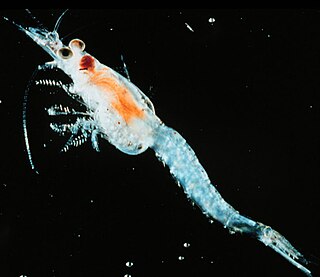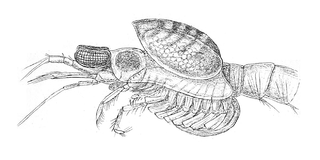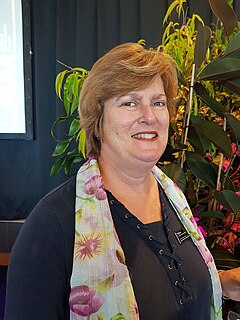
Mysidae is the largest family of crustaceans in the order Mysida, with over 1000 species in around 170 genera.
In marine and freshwater ecology, a particle is a small object. Particles can remain in suspension in the ocean or freshwater. However, they eventually settle and accumulate as sediment. Some can enter the atmosphere through wave action where they can act as cloud condensation nuclei (CCN). Many organisms filter particles out of the water with unique filtration mechanisms. Particles are often associated with high loads of toxins which attach to the surface. As these toxins are passed up the food chain they accumulate in fatty tissue and become increasingly concentrated in predators. Very little is known about the dynamics of particles, especially when they are re-suspended by dredging. They can remain floating in the water and drift over long distances. The decomposition of some particles by bacteria consumes much oxygen and can cause the water to become hypoxic.

Mysis is a genus of mysid crustaceans in the family Mysidae, distributed mainly in the coastal zone of the Arctic and high boreal seas. Several species also inhabit northern freshwater lakes and the brackish Caspian Sea. Fifteen species are recognized. Body lengths range from 1 to 3 centimetres.
Platyops sterreri is a species of crustacean in the family Mysidae, endemic to Bermuda, the only species in the genus Platyops.

Ii clan is a Japanese clan which originates in Tōtōmi Province. It was a retainer clan of the Imagawa family, and then switched sides to the Matsudaira clan of Mikawa Province at the reign of Ii Naotora. A famed 16th-century clan member, Ii Naomasa, adopted son of Ii Naotora, was Tokugawa Ieyasu's son-in-law and one of his most important generals. He received the fief of Hikone in Ōmi Province as a reward for his conduct in battle at Sekigahara. The Ii and a few sub-branches remained daimyō for the duration of the Edo period. Ii Naosuke, the famed politician of the late Edo period, was another member of this clan.

Ii Naokatsu was a Japanese daimyō of the Edo period who served the Tokugawa clan. He was also known as Ii Naotsugu. His childhood name was Manchiyo (万千代). Naokatsu succeeded to family headship following his father's death in 1602. Under Tokugawa Ieyasu's orders, Naokatsu completed construction of Hikone Castle in 1606, and then moved there from Sawayama Castle when it was largely completed. In 1614, as Naokatsu was ill, he sent his brother Naotaka to fight in the Siege of Osaka; Naokatsu himself was assigned to Annaka, where he undertook security duty in the Kantō region. After the siege of Osaka, Tokugawa Ieyasu rewarded Naokatsu's younger brother Naotaka with the Ii family headship, and allowed Naokatsu to form a branch family with holdings at the fief of Annaka in Kōzuke Province, worth 30,000 koku. Naokatsu retired in 1632, yielding headship to his son Naoyoshi. He died in Ōmi Province in 1662.

Neomysis is a genus of opossum shrimp from the family Mysidae, distributed in the coastal zone of temperate seas of the Northern Hemisphere and South America. Several species, particularly from the West Pacific, are also found in fresh and brackish waters. The genus contains the following 18 species:

Pteropurpura is a genus of sea snails, marine gastropod mollusks in the subfamily Ocenebrinae of the family Muricidae, the murex snails or rock snails.
Paramysis bakuensis is a species of mysid crustacean from the family Mysidae, named by the locality from where it was originally described, the town of Baku in Azerbaijan by the Caspian Sea.
Mysidopsis is a genus of mysid shrimps in the family Mysidae. The sensitivity of these shrimps to water quality makes them suitable for bioassays. Mysidopsis bahia and Mysidopsis almyra, which are used frequently to test for pesticides and other toxic substances, are now classified as Americamysis bahia and Americamysis almyra.

Americamysis is a genus of mysid shrimps in the family Mysidae. The sensitivity of these shrimps to water quality makes them suitable for bioassays. Americamysis bahia and Americamysis almyra, which are used frequently to test for pesticides and other toxic substances, are often referred to as Mysidopsis bahia and Mysidopsis almyra in the literature.

Erythrops is a genus of marine crustaceans in the family Mysidae.
Erythrops elegans is a species of crustaceans in the family Mysidae. It is found in the northeastern Atlantic Ocean and in the Mediterranean Sea.

Wilma M. Blom is a marine scientist. Since 2011 she has been Curator, Marine Invertebrates at Auckland War Memorial Museum.
Seishin-ni, born as Hachinohe Neneko or Nene (祢々), Mego (女古,女子) was a Japanese noble woman from the Sengoku period and early Edo period. She became the 21st leader of the Hachinohe clan after Hachinohe Naomasa's death in 1614.

Heteromysis is a genus of marine mysid crustaceans from the family Mysidae, associated with various shallow-water invertebrates. The name describes differentiation of its pereiopods as possible adaptation to commensal life-style. Heteromysis is one of the largest mysid genera, containing more than 100 species. The genus is distributed globally, but predominantly in tropical and subtropical waters.
Paramysis intermedia is a species of shrimp in the family Mysidae. Its natural distribution is Ponto-Caspian, but it is also invasive species, e.g. on the Baltic coast of Estonia. It tolerates salinities between 0–12 ppt; it occurs in estuaries but does not penetrate very deep into rivers.
Neobirsteiniamysis is a mysid crustacean genus of the subfamily Boreomysinae of the family Mysidae. Some of the largest mysids. Exclusively deep water. Cosmopolitan. 2 species.
Neobirsteiniamysis inermis is a deepwater mysid crustacean species of the genus Neobirsteiniamysis. One of the largest and the only known mysid, distributed in both polar regions.

Anisomysis is a genus of mysids, first described in 1910 by Hans Jacob Hansen.











